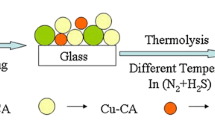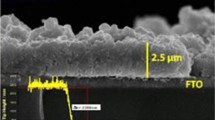Abstract
The electrodeposited precursor is a mixture of Cu, Sn, and Zn alloys, these elements form Cu6Sn5 and CuZn binary phases, and subsequently these phases transform into many binary and ternary intermediates, such as CuS, ZnS, Cu2SnS3, and Cu2ZnSnS4 (CZTS) at low annealing temperature in pure sulfur and H2S atmospheres. Finally, CZTS films can be completely formed by sulfidizing at 550 °C for 1 h in pure sulfur and H2S atmospheres. However, the initial temperature of synthesizing CZTS in H2S atmosphere is higher than that in pure sulfur atmosphere, but the highest temperature of synthesizing CZTS in H2S atmosphere is lower than that in pure sulfur atmosphere. The direct band gaps of the CZTS films synthesized at 550 °C for 1 h in pure sulfur and H2S atmospheres are about 1.54 and 1.52 eV, respectively.








Similar content being viewed by others
References
Bag S, Gunawan O, Gokmen T, Zhu Y, Todorov TK, Mitzi DB. Low band gap liquid-processed CZTSe solar cell with 10.1 % efficiency. Energy Environ Sci. 2012;5:7060.
Barkhouse DAR, Gunawan O, Gokmen T, Todorov TK, Mitzi DB. Device characteristics of a 10.1 % hydrazine-processed Cu2ZnSn(Se,S)4 solar cell. Prog Photovolt Res Appl. 2012;20(1):6.
Todorov TK, Tang J, Bag S, Gunawan O, Gokmen T, Zhu Y, Mitzi DB. Beyond 11 % efficiency: characteristics of state-of-the-art Cu2ZnSn(S,Se)4 solar cells. Adv Energy Mater. 2013;3(1):34.
Chen S, Walsh A, Gong XG, Wei SH. Classification of lattice defects in the kesterite Cu2ZnSnS4 and Cu2ZnSnSe4 earth-abundant solar cell absorbers. Adv Mater. 2013;25(11):1522.
Peter LM. Towards sustainable photovoltaics: the search for new materials. Philos Trans R Soc A Math Phys Eng Sci. 2011;369:1840.
Emrani A, Vasekar P, Westgate CR. Effects of sulfurization temperature on CZTS thin film solar cell performances. Sol Energy. 2013;98:335.
Shin B, Gunawan O, Zhu Y, Bojarczuk NA, Chey SJ, Guha S. Thin film solar cell with 8.4 % power conversion efficiency using an earth abundant Cu2ZnSnS4 absorber. Prog Photovolt Res Appl. 2013;21(1):72.
Deligianni H, Ahmed S, Romankiw LT. The next frontier: electrodeposition for solar cell fabrication. Interface. 2011;20:47.
Chen YS, Wang YJ, Li R, Gu JH, Lu JX, Yang SE. Preparing Cu2ZnSnS4 films using the co-electro-deposition method with ionic liquids. Chin Phys B. 2012;21(5):058801.
Ennaoui A, Lux-Steiner M, Weber A, Abou-Ras D, Kötschau I, Schock HW, Schurr R, Hölzing A, Jost S, Hock R, Voß T, Schulze J, Kirbs A. Cu2ZnSnS4 thin film solar cells from electroplated precursors: novel low-cost perspective. Thin Solid Films. 2009;517(7):2511.
Araki H, Kubo Y, Jimbo K, Maw WS, Katagiri H, Yamazaki M, Oishi K, Takeuchi A. Preparation of Cu2ZnSnS4 thin films by sulfurization of coelectroplated Cu–Zn–Sn precursors. Phys Status Solidi C. 2009;6(5):1266.
Araki H, Kubo Y, Mikaduki A, Jimbo K, Maw WS, Katagiri H, Yamazaki M, Oishi K, Takeuchi A. Preparation of Cu2ZnSnS4 thin films by sulfurizing electroplated precursors. Sol Energy Mater Sol Cells. 2009;93:996.
Lehner J, Ganchev M, Loorits M, Revathi N, Raadik T, Raudoja J, Grossberg M, Mellikov E, Volobujeva O. Structural and compositional properties of CZTS thin films formed by rapid thermal annealing of electrodeposited layers. J Cryst Growth. 2013;380:236.
Scragg JJ, Berg DM, Dale PJ. A 3.2 % efficient kesterite device from electrodeposited stacked elemental layers. J Electroanal Chem. 2010;646(1–2):52.
Ahmed S, Reuter KB, Gunawan O, Guo L, Romankiw LT, Deligianni H. A high efficiency electrodeposited Cu2ZnSnS4 solar cell. Adv Energy Mater. 2012;2(2):253.
Acknowledgments
This work was financially supported by the National Natural Science Foundation of China (No. 61176062), the Foundation of Nanjing Institute of Technology (No. ZKJ201302), Jiangsu Innovation Practice Training Projects for College Students (No. 201311276044X), and the Undergraduate Technology Innovation of Nanjing Institute of Technology (Nos. N20130224 and N20140206).
Author information
Authors and Affiliations
Corresponding author
Rights and permissions
About this article
Cite this article
He, XC., Shen, HL., Pi, JH. et al. Synthesis and optical properties of Cu2SnZnS4 films under different sulfur atmospheres. Rare Met. 37, 808–814 (2018). https://doi.org/10.1007/s12598-014-0350-z
Received:
Revised:
Accepted:
Published:
Issue Date:
DOI: https://doi.org/10.1007/s12598-014-0350-z




